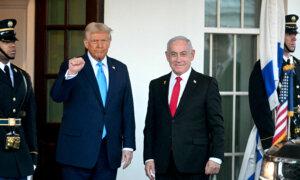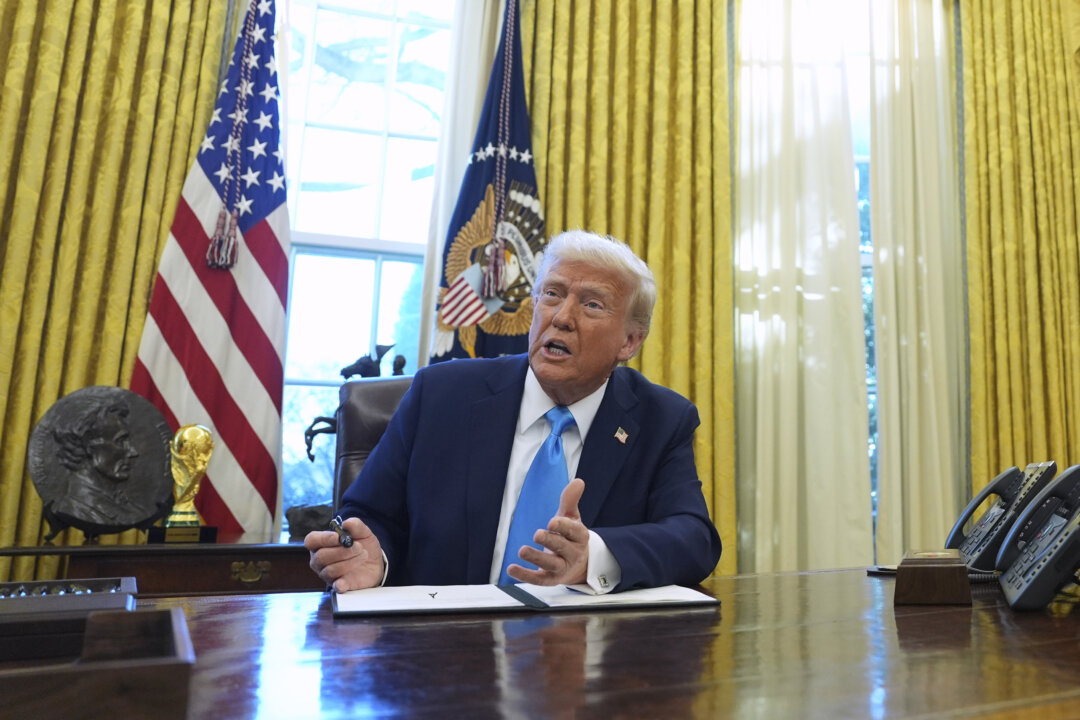‘For decades, our country has been looted, pillaged, raped, and plundered by nations near and far, both friend and foe alike,’ Trump said.
The United States will implement a 10 percent across-the-board tariff on all imports as part of the Trump administration’s reciprocal tariffs on all nations.
President Donald Trump unveiled sweeping reciprocal tariffs at the White House Rose Garden on April 2, calling it America’s “declaration of economic independence” and one of the most important days in U.S. history.
The president will sign an executive order implementing reciprocal tariffs on countries worldwide.
“Reciprocal. That means they do it to us, and we do it to them. Very simple. Can’t get any simpler than that,” he said.
“For decades, our country has been looted, pillaged, raped, and plundered by nations near and far, both friend and foe alike.”
The United States will implement a baseline tariff rate of 10 percent, which will go into effect on April 5 at 12:01 a.m.
Higher reciprocal rates will be imposed on countries on the “worst offenders” list. These will take effect on April 9 at 12:01 a.m. The White House estimates that around 60 countries are on this list.
Trump outlined some of the tariff rates on U.S. trading partners. The United States will impose a 34 percent levy on China, a 46 percent tariff on Vietnam, and 20 percent on the European Union.
Tariffs will be declared a national emergency through the International Emergency Economic Powers Act (IEEPA), a 1977 law authorizing the president to impose trade restrictions on foreign countries.
Trump invoked this Act in February and implemented tariffs on Canada, Mexico, and China, alleging illicit drug and illegal immigration threats.
White House officials say there have been unfair trade practices and a lack of reciprocity by U.S. trade partners. These actions have fueled massive trade deficits, “undermining our national and economic security,” according to officials.
Last year, the United States registered a record $1.2 trillion goods trade deficit.
While the administration seeks to address high tariff rates, officials say that the bigger problem is other countries’ non-tariff barriers. The White House identified various examples of how foreign governments utilize non-monetary trade restrictions.
China, for example, will circumvent tariffs by relying on a “going out” strategy using third-party countries such as Cambodia, Indonesia, Thailand, and Vietnam.
“The problem with Vietnam is not their tariffs,” a White House official said on a call with reporters before Trump’s “Make America Wealthy Again” event. “The problem is everything else they do, including setting up shop for Communist China to send us things.”
Israel, which announced it would eliminate remaining tariffs on U.S. goods, engages in intellectual property theft of American pharmaceutical manufacturing, the official said.
Officials pointed to several countries that place restrictions on U.S. agricultural exports. Brazil requires licenses to import agricultural goods. Australia bans U.S. beef, while Mexico limits the amount that can enter the country.
Trump also pointed to Australia’s measure.
“They don’t want it because they don’t want it to affect their farmers, and you know what, I don’t blame them, but we’re doing the same thing right now starting about midnight tonight,” the president said.
Overall, the administration says the president wants to “pursue reciprocal trade together.”
“This is something where we can start to reshore our manufacturing,” an official said. “Our farmers can have the fair treatment they deserve in other countries.”
Market Reaction
While U.S. stocks finished the April 2 session in positive territory, the financial markets slumped in after-hours trading after the president announced details of his tariff plans.
The tech-driven Nasdaq Composite Index plunged by about 500 points, or 2.5 percent.
The broader S&P 500 declined by nearly 90 points, or 1.5 percent.
The blue-chip Dow Jones Industrial Average erased about 200 points, or 0.5 percent.
U.S. Treasury yields were mixed, with the benchmark 10-year at around 4.14 percent.
The U.S. dollar index, a gauge of the buck against a weighted basket of currencies, tumbled by 0.25 percent.
‘The Big One’
Trump first mentioned his sweeping reciprocal tariffs in February, preparing the public on the social media platform Truth Social for “the big one.”
At a press event from the Oval Office, Trump signed a memo dubbed the “Fair and Reciprocal Plan.” This established a roadmap for imposing reciprocal tariffs on all nations that charge the United States import duties.
“They charge us a tax or tariff, and we charge them,” Trump said, adding that his administration is seeking a level playing field.
According to data from the U.S. Trade Representative, the United States maintained a weighted average import tariff rate of about 2 percent.
Trump also ordered officials to produce reports determining appropriate tariff levels for each affected country.
The U.S. Trade Representative released the 2025 National Trade Estimate Report, a comprehensive examination of barriers installed by trading partners and the hurdles that U.S. exports must overcome.
Since the February announcement, the White House has presented mixed messaging on the president’s tariff plans.
Treasury Secretary Scott Bessent has stated that the United States could target countries with persistent trade deficits, also known as the “dirty 15.” These are the 15 percent of nations that trade significantly with the United States and have immense trade deficits.
“Going into April 2, some of our worst trading partners in terms of the way they treat us have already come to President Trump offering substantial decreases in very unfair tariffs,” Bessent said in a March 18 interview with Fox News host Maria Bartiromo.
Bessent noted that some tariffs may not be implemented because of pre-negotiated agreements or that some countries will discuss lowering levies once they receive their reciprocal tariff number.
Some countries have already responded to the president’s reciprocal tariff plans. India has indicated it is willing to slash tariff rates on half of U.S. imports. Vietnam has lowered import duties on a range of American products entering the Southeast Asian country. Israel has confirmed it will remove the remaining tariffs on U.S. products.
Later, Trump would confirm that reciprocal tariffs would target all countries, though he might be a bit more lenient.
“I may give a lot of countries breaks,” he told reporters at a news conference, indicating that some countries have charged the United States so much that they could not handle higher tariff rates.
“I don’t think they could take it,” the president said. “In other words, they’ve charged us so much that I’m embarrassed to charge them what they’ve charged.”
Recession, Inflation Fears Everywhere
Recession and inflation fears have gripped Main Street and Wall Street for several weeks.
U.S. stocks have plunged on tariff-fueled concerns, consumer sentiment has tanked, and expectations of slower economic growth and higher prices have intensified.
Trump and administration officials have largely dismissed the prevalence of inflation and recession forecasts.
“I don’t see it [recession] at all,” he told reporters at a White House event last month. “I think this country is going to boom. I think we’re going to have the greatest markets we’ve ever had.”
Bessent, in an interview with NBC’s “Meet the Press,” stated that while there are “no guarantees” that the U.S. economy will slip into a recession, “there is no reason that it has to.”
Commerce Secretary Howard Lutnick also told the program that Americans should “absolutely not” brace for a recession.
“There’s going to be no recession in America. Global tariffs are going to come down because President Trump has said: ‘You want to charge us 100 percent? We’re going to charge you 100 percent,'” Lutnick stated.
“So, if Donald Trump is bringing growth to America, I would never bet on recession, no chance.”
As for prices, Bessent thinks there might be a one-time adjustment, but he is not worried about inflation “across a continuum.”
Lutnick expects “distortions” in the global marketplace as tariffs are enacted.
“Foreign goods may get a little more expensive. But American goods are going to get cheaper, and you’re going to be helping Americans by buying American,” he said.
Economic observers, navigating through turbulence, have sought clarity since the reciprocal tariff plans were released.
“Now we wait for clarity and hope we can get some on the tariff front,” Jay Woods, chief global strategist at Freedom Capital Markets, said in a note emailed to The Epoch Times.
“The lack of certainty and the shroud of secrecy have been driving the market insane.”










